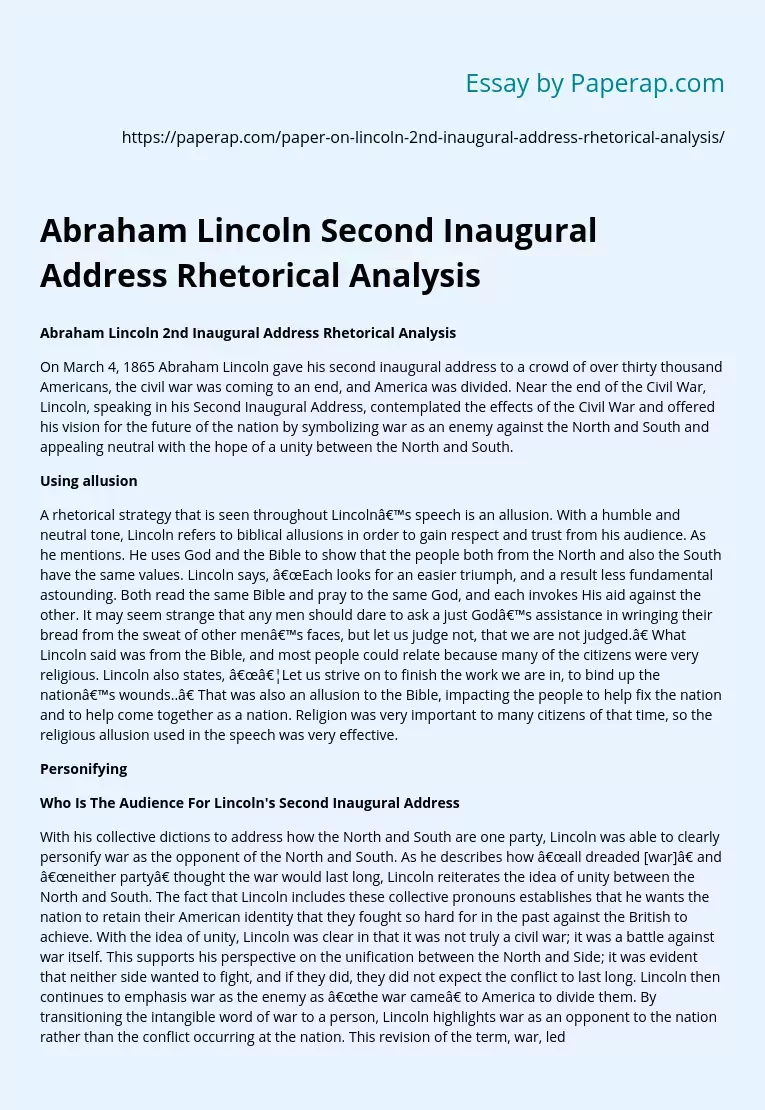Abraham Lincoln Second Inaugural Address Rhetorical Analysis
Abraham Lincoln 2nd Inaugural Address Rhetorical Analysis
On March 4, 1865 Abraham Lincoln gave his second inaugural address to a crowd of over thirty thousand Americans, the civil war was coming to an end, and America was divided. Near the end of the Civil War, Lincoln, speaking in his Second Inaugural Address, contemplated the effects of the Civil War and offered his vision for the future of the nation by symbolizing war as an enemy against the North and South and appealing neutral with the hope of a unity between the North and South.
Using allusion
A rhetorical strategy that is seen throughout Lincoln’s speech is an allusion. With a humble and neutral tone, Lincoln refers to biblical allusions in order to gain respect and trust from his audience. As he mentions. He uses God and the Bible to show that the people both from the North and also the South have the same values. Lincoln says, “Each looks for an easier triumph, and a result less fundamental astounding.
Both read the same Bible and pray to the same God, and each invokes His aid against the other. It may seem strange that any men should dare to ask a just God’s assistance in wringing their bread from the sweat of other men’s faces, but let us judge not, that we are not judged.” What Lincoln said was from the Bible, and most people could relate because many of the citizens were very religious. Lincoln also states, “…Let us strive on to finish the work we are in, to bind up the nation’s wounds.
.” That was also an allusion to the Bible, impacting the people to help fix the nation and to help come together as a nation. Religion was very important to many citizens of that time, so the religious allusion used in the speech was very effective.
Personifying
Who Is The Audience For Lincoln’s Second Inaugural Address
With his collective dictions to address how the North and South are one party, Lincoln was able to clearly personify war as the opponent of the North and South. As he describes how “all dreaded [war]” and “neither party” thought the war would last long, Lincoln reiterates the idea of unity between the North and South. The fact that Lincoln includes these collective pronouns establishes that he wants the nation to retain their American identity that they fought so hard for in the past against the British to achieve. With the idea of unity, Lincoln was clear in that it was not truly a civil war; it was a battle against war itself. This supports his perspective on the unification between the North and Side; it was evident that neither side wanted to fight, and if they did, they did not expect the conflict to last long. Lincoln then continues to emphasis war as the enemy as “the war came” to America to divide them. By transitioning the intangible word of war to a person, Lincoln highlights war as an opponent to the nation rather than the conflict occurring at the nation. This revision of the term, war, led to the realization of what they were actually fighting for: to retain their unity and not own individual reasons. Lincoln’s intended effect of personifying war is not only to alert the nation of their true goal of unity, but to clarify war as the proper enemy.
Appealing to ethos
Lincoln was the president of the United States so he was a very credible figure, people knew that they were receiving information from a reliable source. He appealed to ethos by trying to make those listening think like him. When Lincoln states that, “The progress of our arms, upon which all else chiefly depends, is as well known to the public as to myself, and it is, I trust, reasonably satisfactory and encouraging to all”, he is letting his audience know that he truly believes in the United States’ military and they should too.
Reciting
Lincoln also recites, “With malice toward none, with charity for all, with firmness in the right as God gives us to see the right, let us strive on to finish the work we are in, to bind up the nation’s wounds “. Here he uses words that indicate togetherness like “for all”, “we” and “us”.
Abraham Lincoln Second Inaugural Address Rhetorical Analysis. (2019, Dec 05). Retrieved from https://paperap.com/paper-on-lincoln-2nd-inaugural-address-rhetorical-analysis/

